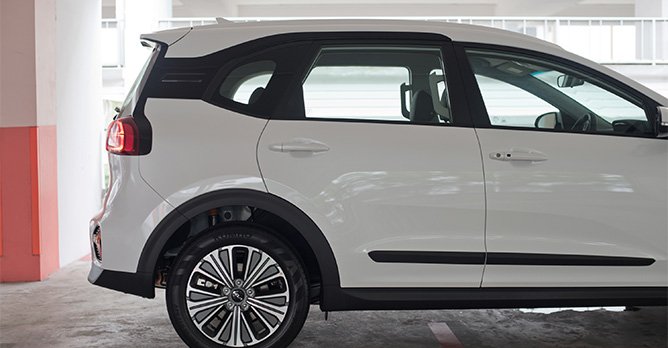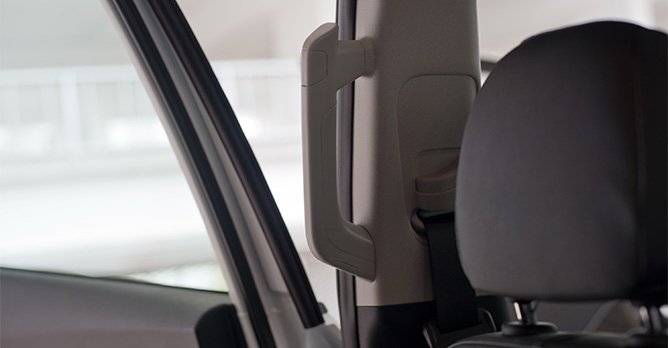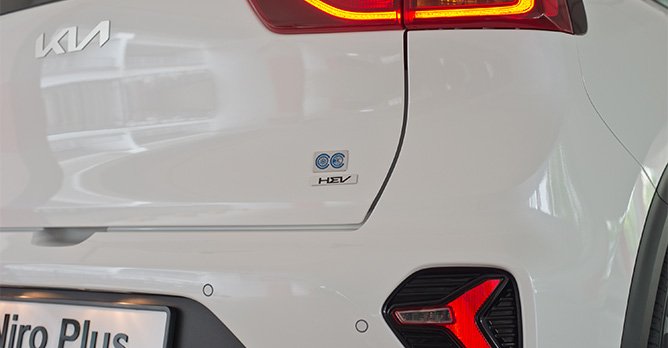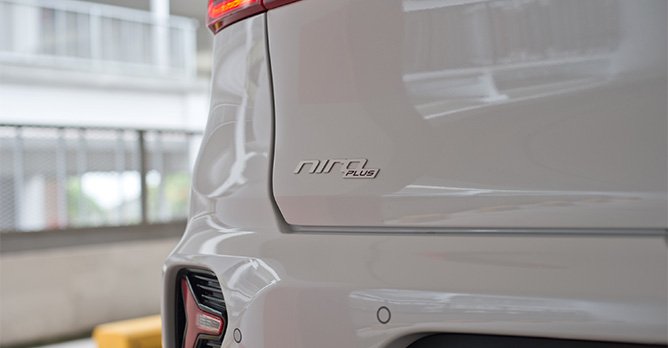Kia Niro Plus Hybrid 1.6 (A) Review
07 Mar 2023|26,313 views
What We Like
Distinct design that is visually reminiscent of older breed of mini MPVs
Excellent headroom for second row passengers
Good range of safety features and alerts
Great all-round visibility
What We Dislike
'Purpose-built vehicle' roots are best realised in pure EV form
Drivetrain could do with better refinement
Just as the world thought that Kia was moving on to the second generation of its groundbreaking Niro crossover, the firm pulled back slightly with an unexpected and intriguing twist.
The Niro was already a trailblazer in its own right as the first bespoke electrified model of Kia's range, offered as a hybrid, plug-in hybrid or BEV. Thinking that it still had some untapped potential left to unleash, however, it seemed the Korean marque thought it fit to give the car another torch to carry.
With some literal reshaping, what has emerged is the Niro Plus - Kia's first-ever purpose-built vehicle (PBV). In bearing the image of what the firm thinks a car specifically designed for ride-hailing and passenger-carrying should be, it also manages to stand out as quite a unique offering in the market today.
From crossover to mini-MPV
If all you saw was its 'tiger-nosed' face peeking out from a row of cars at your local MSCP, you'd pass the Niro Plus off as just an older Niro EV. But come further up close, and its distinct shape will start to take hold.
What has been added to the equation most obviously is 80mm in height - less obviously, 10mm in length as well. The sense of an 'extra layer' being piled onto the standard car is accentuated further by black body panels on the upper sides, which start just over the rear doors, then dissect the D-pillars towards the tailgate.
Modified as such, the Niro Plus half-relinquishes the trendier crossover styling of its tinier twin for a look that is far less common today. For those old enough to remember, there are flashes of the Skoda Yeti and Roomster; even of the dying breed of once-commonplace mini MPVs like the Ford B-Max and Renault Modus. It doesn't feel wrong to call it the Korean foil to Toyota's dependable little JPN Taxis plying Tokyo's streets.
Having said that, since the Niro Plus rides on well-sized 17-inch wheels, the car doesn't appear like it's walking on stilts in spite of the added visual bulk. In fact, spend enough time with the car (as we did), and the 'standard' Niro might start to appear oddly downsized.
Raising the roof for passenger-carrying
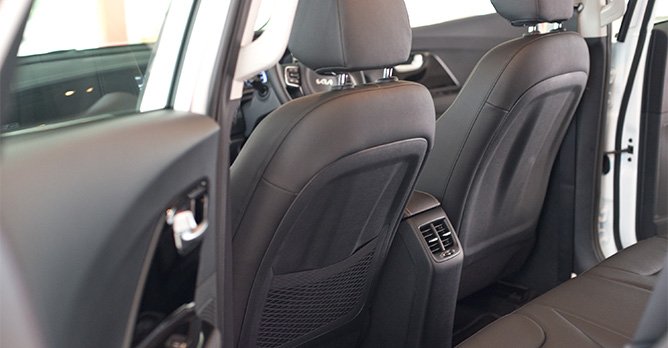
Now imagine an upsized version of this already-solid base template.
Built with passenger-ferrying as one of its core duties, headroom is outstanding in the rear of the Niro Plus. That raised roof is no gimmick; even those with the tallest torsos will find themselves quite far from brushing their heads on the car's headliner, while the added height in the boot means more carrying capacity (Kia says three large luggages and a folded wheelchair will fit no problem). Having larger windows also allows more light to flood in, creating an airier space on the inside.
Although the wheelbase of the Niro Plus remains unchanged over the Niro, Kia says thinner door and seat structures help boost overall space. Truthfully, the average Joe is unlikely to notice these enhancements immediately, but what cannot be denied is that legroom and shoulder room are more than adequate for three average Singaporean adults sitting abreast.
Finally, the purpose-built nature of the Niro Plus is embodied most clearly in handles attached to its B-pillars. Any driver that has played chaffeur to
Eyes still on the driver
Amidst these passenger-centric modifications, the Niro Plus is quick to assure the driver that it hasn't forgotten about its quality of life as well - bank account included.
The same drivetrain from the first-gen Niro Hybrid reappears here, within which a 1.6-litre naturally aspirated engine works together with a 32kW motor (powered by a 1.56kWh battery) to produce 139bhp and 265Nm of torque.
Our drive was mostly carried out within urban areas and in stop-and-go traffic, and we managed 17.3km/L - not quite the 18.9km/L mentioned by Kia, but still a commendable consumption figure by any measure. A driver of better sensibilities would only need to pull back into a station for unleaded every 800km.
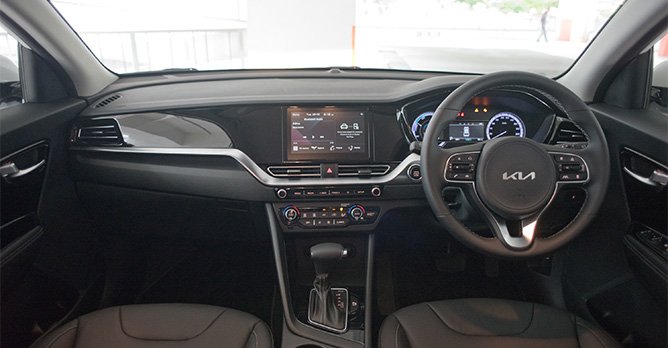
Ease-of-navigation and audio entertainment are guaranteed too, with standard wireless Apple Carplay and wired Android Auto connectivity.
Admittedly, the Niro Plus isn't perfect. Gear shifts from its six-speed dual-clutch transmission are not the snappiest, and it doesn't fuse combustion and electric power the most seamlessly. Some road noise also does intrude when cruising along the expressway, and it's impossible to deny that the general user experience feels slightly dated.
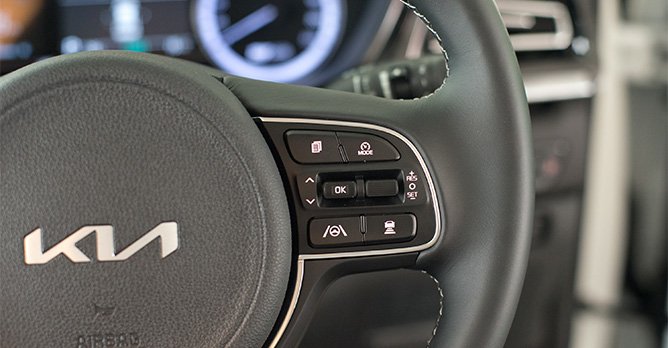
As a vehicle designed to be on the move constantly, the Niro Plus excels at adapting to its environment. In urban traffic, its greenhouse-likeness contributes to excellent all-round visibility, even as its manageable size makes manoeuvring tighter areas easy.
And despite its extra weight, the car isn't sluggish. It gets up to the speed limit without breaking much sweat, after which it feels stable, and still fully capable of pulling itself along. Enlarged the car may well be; compromised the driving experience is not.
For all intents and purposes?
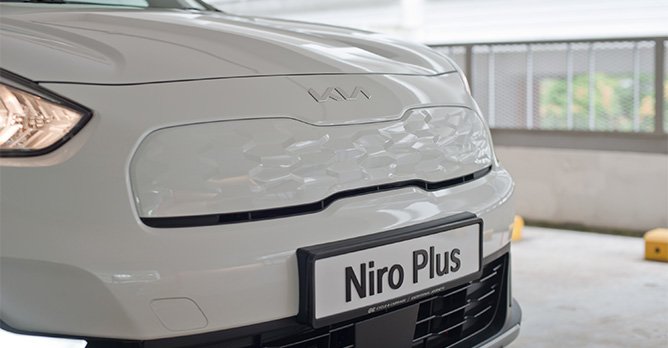
Where other economical cars have unintentionally (and perhaps unwillingly) found favour with PHV-fleet operators, this one dives headlong into that crowd by embracing its passenger-ferrying cause unabashedly.
In the process, it paradoxically carves out a delightfully striking image for itself that is quite left-of-centre, all while remaining a practical runabout at its very core. Without even getting to know it properly, you already know this will ferry a family of five around in good comfort and economy.
Yet, this isn't where things end.
Towards 2030, an entire line of all electric PBVs built on a bespoke platform by Kia will slowly be unveiled to serve even more 'mobility requirements'. The Niro Plus EV, due here before year-end, gives an expanded glimpse of that as-yet murky vision: It boasts V2L capabilities, and can be optioned with camping-specific add-ons (including a foldable table you can attach to the boot wall) in Korea.
The inexplicable magnetism of the Niro Plus Hybrid may just lie in these combined qualities.
The times are changing, and one of the key trends of today's amorphous transport landscape is the blurring of lines between ride-hailing and private-use vehicles. Distilled into this unpretentious and charming crossover-turned-MPV, the Niro Plus is a welcome, first vehicular taste we're getting of that change - and an extremely well-priced one at that.
The Kia Niro Plus Hybrid is now available for private-hire leasing via BIS Motoring. Additionally, the car is also available to the public for purchase via Cycle & Carriage. Prices start at $154,999, inclusive of COE (as of 22 February 2023).
Check out what we had to say about the current generation Kia Niro Hybrid below:
Kia's Niro Hybrid now has a futuristic yet approachable look, and the largest gripe some had with its predecessor has also been fixed
And here's our review of the first-gen Kia Niro Hybrid if you need a refresher:
In its first bid at a hybrid vehicle, Kia has produced a car that offers up an intriguing blend of two worlds
What We Like
Distinct design that is visually reminiscent of older breed of mini MPVs
Excellent headroom for second row passengers
Good range of safety features and alerts
Great all-round visibility
What We Dislike
'Purpose-built vehicle' roots are best realised in pure EV form
Drivetrain could do with better refinement
Just as the world thought that Kia was moving on to the second generation of its groundbreaking Niro crossover, the firm pulled back slightly with an unexpected and intriguing twist.
The Niro was already a trailblazer in its own right as the first bespoke electrified model of Kia's range, offered as a hybrid, plug-in hybrid or BEV. Thinking that it still had some untapped potential left to unleash, however, it seemed the Korean marque thought it fit to give the car another torch to carry.
With some literal reshaping, what has emerged is the Niro Plus - Kia's first-ever purpose-built vehicle (PBV). In bearing the image of what the firm thinks a car specifically designed for ride-hailing and passenger-carrying should be, it also manages to stand out as quite a unique offering in the market today.
From crossover to mini-MPV
If all you saw was its 'tiger-nosed' face peeking out from a row of cars at your local MSCP, you'd pass the Niro Plus off as just an older Niro EV. But come further up close, and its distinct shape will start to take hold.
What has been added to the equation most obviously is 80mm in height - less obviously, 10mm in length as well. The sense of an 'extra layer' being piled onto the standard car is accentuated further by black body panels on the upper sides, which start just over the rear doors, then dissect the D-pillars towards the tailgate.
Modified as such, the Niro Plus half-relinquishes the trendier crossover styling of its tinier twin for a look that is far less common today. For those old enough to remember, there are flashes of the Skoda Yeti and Roomster; even of the dying breed of once-commonplace mini MPVs like the Ford B-Max and Renault Modus. It doesn't feel wrong to call it the Korean foil to Toyota's dependable little JPN Taxis plying Tokyo's streets.
Having said that, since the Niro Plus rides on well-sized 17-inch wheels, the car doesn't appear like it's walking on stilts in spite of the added visual bulk. In fact, spend enough time with the car (as we did), and the 'standard' Niro might start to appear oddly downsized.
Raising the roof for passenger-carrying

Now imagine an upsized version of this already-solid base template.
Built with passenger-ferrying as one of its core duties, headroom is outstanding in the rear of the Niro Plus. That raised roof is no gimmick; even those with the tallest torsos will find themselves quite far from brushing their heads on the car's headliner, while the added height in the boot means more carrying capacity (Kia says three large luggages and a folded wheelchair will fit no problem). Having larger windows also allows more light to flood in, creating an airier space on the inside.
Although the wheelbase of the Niro Plus remains unchanged over the Niro, Kia says thinner door and seat structures help boost overall space. Truthfully, the average Joe is unlikely to notice these enhancements immediately, but what cannot be denied is that legroom and shoulder room are more than adequate for three average Singaporean adults sitting abreast.
Finally, the purpose-built nature of the Niro Plus is embodied most clearly in handles attached to its B-pillars. Any driver that has played chaffeur to
Eyes still on the driver
Amidst these passenger-centric modifications, the Niro Plus is quick to assure the driver that it hasn't forgotten about its quality of life as well - bank account included.
The same drivetrain from the first-gen Niro Hybrid reappears here, within which a 1.6-litre naturally aspirated engine works together with a 32kW motor (powered by a 1.56kWh battery) to produce 139bhp and 265Nm of torque.
Our drive was mostly carried out within urban areas and in stop-and-go traffic, and we managed 17.3km/L - not quite the 18.9km/L mentioned by Kia, but still a commendable consumption figure by any measure. A driver of better sensibilities would only need to pull back into a station for unleaded every 800km.

Ease-of-navigation and audio entertainment are guaranteed too, with standard wireless Apple Carplay and wired Android Auto connectivity.
Admittedly, the Niro Plus isn't perfect. Gear shifts from its six-speed dual-clutch transmission are not the snappiest, and it doesn't fuse combustion and electric power the most seamlessly. Some road noise also does intrude when cruising along the expressway, and it's impossible to deny that the general user experience feels slightly dated.

As a vehicle designed to be on the move constantly, the Niro Plus excels at adapting to its environment. In urban traffic, its greenhouse-likeness contributes to excellent all-round visibility, even as its manageable size makes manoeuvring tighter areas easy.
And despite its extra weight, the car isn't sluggish. It gets up to the speed limit without breaking much sweat, after which it feels stable, and still fully capable of pulling itself along. Enlarged the car may well be; compromised the driving experience is not.
For all intents and purposes?

Where other economical cars have unintentionally (and perhaps unwillingly) found favour with PHV-fleet operators, this one dives headlong into that crowd by embracing its passenger-ferrying cause unabashedly.
In the process, it paradoxically carves out a delightfully striking image for itself that is quite left-of-centre, all while remaining a practical runabout at its very core. Without even getting to know it properly, you already know this will ferry a family of five around in good comfort and economy.
Yet, this isn't where things end.
Towards 2030, an entire line of all electric PBVs built on a bespoke platform by Kia will slowly be unveiled to serve even more 'mobility requirements'. The Niro Plus EV, due here before year-end, gives an expanded glimpse of that as-yet murky vision: It boasts V2L capabilities, and can be optioned with camping-specific add-ons (including a foldable table you can attach to the boot wall) in Korea.
The inexplicable magnetism of the Niro Plus Hybrid may just lie in these combined qualities.
The times are changing, and one of the key trends of today's amorphous transport landscape is the blurring of lines between ride-hailing and private-use vehicles. Distilled into this unpretentious and charming crossover-turned-MPV, the Niro Plus is a welcome, first vehicular taste we're getting of that change - and an extremely well-priced one at that.
The Kia Niro Plus Hybrid is now available for private-hire leasing via BIS Motoring. Additionally, the car is also available to the public for purchase via Cycle & Carriage. Prices start at $154,999, inclusive of COE (as of 22 February 2023).
Check out what we had to say about the current generation Kia Niro Hybrid below:
Kia's Niro Hybrid now has a futuristic yet approachable look, and the largest gripe some had with its predecessor has also been fixed
And here's our review of the first-gen Kia Niro Hybrid if you need a refresher:
In its first bid at a hybrid vehicle, Kia has produced a car that offers up an intriguing blend of two worlds
Thank You For Your Subscription.















































